All About Lambsquarters, or Huauzontles
July 01, 2019 | Updated March 13, 2021
As an Amazon Associate I earn from qualifying purchases.
For the life of me I cannot understand why people hate on the chenopods: Lambsquarters, its Mexican cousin huauzontles, salt bushes and all their various goosefoot friends. All are fantastic greens, with edible flowers and seeds, one of which I am sure you know: quinoa.
I grow two in my garden. I planted huauzontles, Chenopodium nuttalliae, and well, if you look pretty much anywhere, you will find lambsquarters, C. album. These and all their chenopod friends share the same leaf pattern, more or less, and all are incredibly drought tolerant and do just fine in crappy soil.
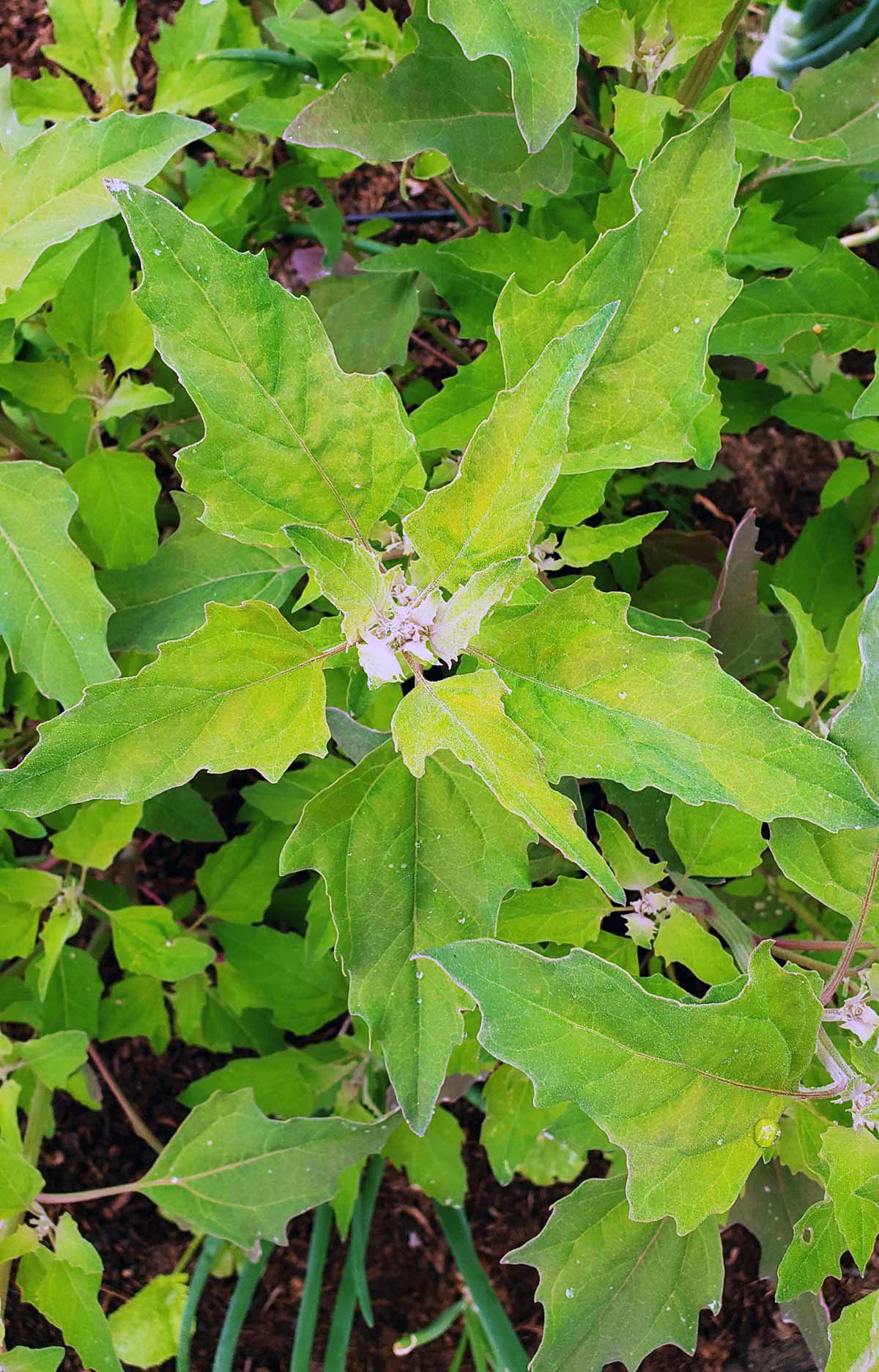
They are all related to amaranth, but while all chenopodium species are amaranths, not all amaranths are chenopodium. I happen to be growing a true amaranth, too, but that’s for another post. And as you can see on this map, some species of lambsquarters, or something very much like it, lives near you.
As for my huauzontles, it’s basically the common lambsquarters on steroids. Bigger, leafier, with larger seed heads, it is clearly what the Aztecs wanted after breeding many generations of regular lambsquarters. It is mostly eaten in the center of Mexico as quelites, in soups (see below), or made into several kinds of fritters.
It wasn’t just the Aztecs who cultivated lambsquarters. Scientists are fairly certain that a variety of Eastern Native American groups cultivated their own goosefoot, C. berlanderii, which is very closely related to huauzontles, as far back as 3800 years ago.
Europe also has its cousin of lambsquarters, called Good King Henry, but it is not, technically speaking, a chenopod. That said, you can use Henry in any recipes that call for lambsquarters or huauzontles. Africa and Asia also grow C. album.
So what happened? Why did these plants get tossed from a valued place in our gardens to the weed heap?
If I had to guess, it is because of those damn brassicas, and their friends spinach and chard. Think about it: Lambsquarters and its cousins have delicious green leaves, but they are not terribly large compared to our modern greens like collards, chard or even spinach. Spinach, incidentally, is also an amaranth.
And, while we still love broccoli, we seem to have forgotten that the teeny “broccoli” tops on the various chenopods are just as good, if not better. We do at least still eat the dried seeds as quinoa or amaranth.
It is notable that in the hot regions of this world, lambsquarters still has a place in the garden. Sacramento, California, where I live, being one of those hot regions.
The reason is simple: You try growing a leafy green of almost any other variety in temperatures consistently over 95°F with humidity often dropping below 15 percent. Spinach won’t last a week in that. Yes, there are other hot weather greens, like New Zealand spinach and Malabar spinach, but the chenopods are easier to grow.

And let’s talk about nutrition. For a typical 100 gram serving, lambsquarters has 43 calories and 4.2 grams of protein, 96 percent of your daily vitamin C needs, 73 percent for vitamin A, and 37 percent for vitamin B2. It’s also high in calcium and manganese. Spinach is not as nutrient dense, with only 23 calories and much lower vitamin C levels, although spinach is higher in vitamins A and K.
How to cook your lambsquarters? Lots of ways.
Obviously they and all their chenopod cousins, hell, add in all the amaranths and orache and atriplex relatives, too, are an excellent substitute for spinach or some other leafy green. That’s how I use them most often.
Some parts of the country call lambsquarters “bacon weed,” because, well… fry up some bacon, remove and chop it, cook a mess of lambsquarters in that bacon fat, maybe with some onions and garlic, add back the bacon as well as a splash of vinegar and you’ll thank me later.
The young seed heads can be eaten like broccoli, added to fritters or soups, as you will see in the simple huauzontles soup below.
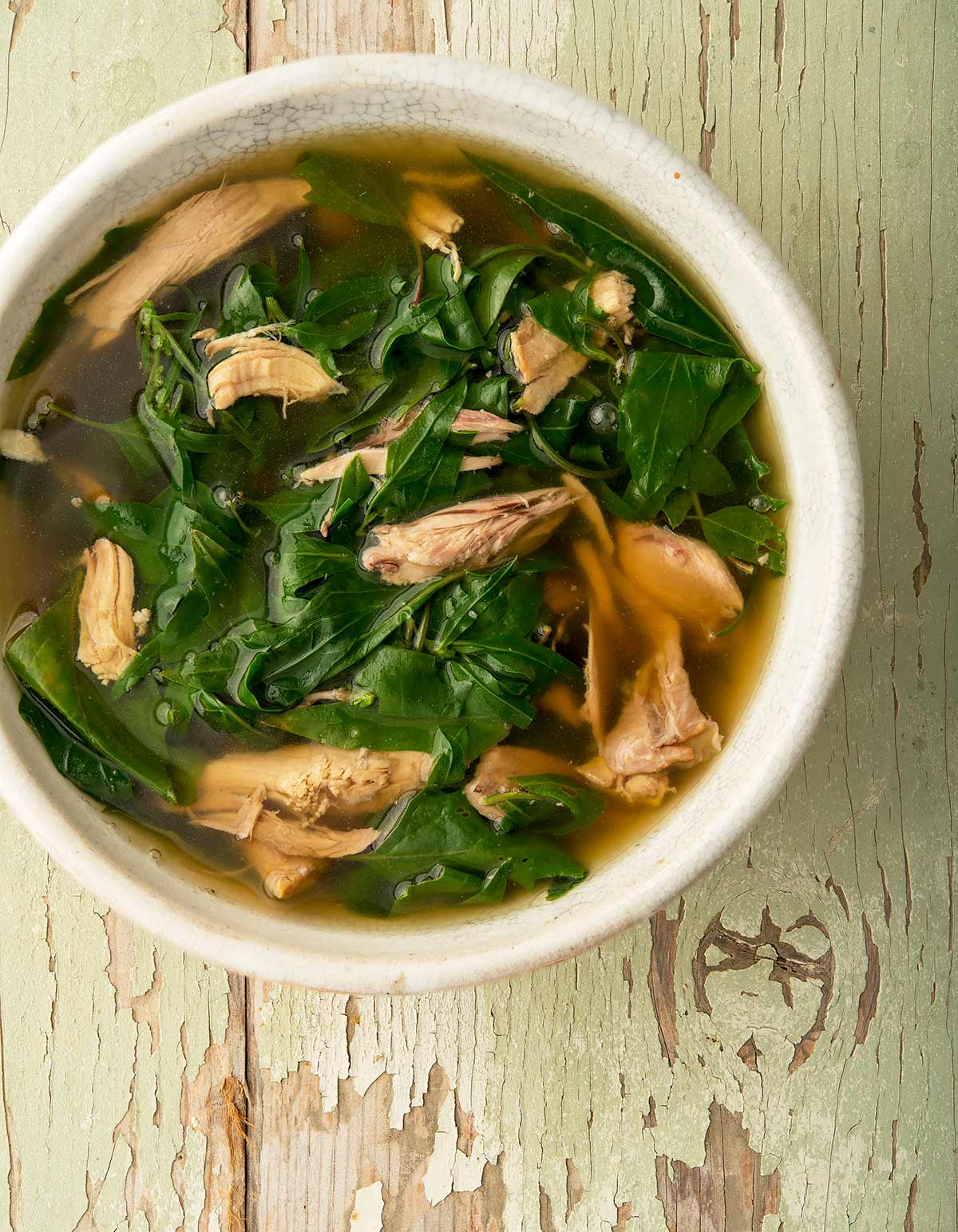
The Indians (from India) call lambsquarters bathua and use it in any place you’d normally see spinach used; saag paneer springs to mind.
What if you have too much? Best to boil your lambsquarters in very salty water for 1 minute, then move them to a big bowl of ice water; this stops enzymatic activity and sets the green color. Squeeze out the excess liquid and vacuum seal them in the freezer.
Identifying Lambsquarters
If you are unsure whether you have lambsquarters in your yard, or anywhere else, for that matter, follow these steps:
- The plant likes disturbed areas, like vacant lots, gardens, and yards. Highly unlikely that you will find lambsquarters in a forest.
- It varies in size from about a foot tall to, well, really big. I’ve seen one almost 6 feet tall before.
- Many times the base of each side stem is pinkish red.
- The leaves are shaped like a diamond, or an arrowhead. They are irregularly lobed. They often have a sort of whitish powder or sheen on their undersides. This is a key identifier.
- The “flowers” are clusters of little green spheres at the top of the plant; incidentally, these are what most people eat in Mexico.
You can also dry lambsquarters for use as a dried green thing in a winter soup.
Speaking of soups, this one is a favorite of mine. Super simple, I first read about it in the excellent book Eat Mexico: Recipes from Mexico City’s Streets, Markets & Fondas. It’s just a simple chicken (or other poultry or rabbit) soup, spiked with lots of huauzontles (lambsquarters), served over rice with some crispy tortilla chips.
Other Ways to Cook Lambsquarters
In short, pretty much any way you would eat any tender, green, leafy vegetable: As I mentioned, think spinach and all its uses.
I will blanch and chop them into Italian ricotta dumplings, add them as a green vegetable in stews like this three sisters stew, or this West African palaver sauce. You can also simply sauté them as you would spinach of kale, with garlic, olive oil, a little chile and a splash of lemon.
Lambsquarters Soup
Ingredients
- 3 pounds turkey, pheasant or chicken wings
- 1 quart chicken broth, or other light broth
- 4 avocado leaves or bay leaves
- 1 sprig epazote (optional)
- 2 teaspoons dried Mexican oregano, or regular oregano
- 1 onion, sliced
- 3 stalks celery, chopped
- 2 pounds lambsquarters, or spinach or some other tender green.
- Lime juice to taste
- cayenne to taste
Instructions
- Put the turkey wings in a soup pot and add the stock, plus 2 quarts of water. Bring to a simmer, then add the avocado or bay leaves, epazote (if using), oregano, onion and celery. Let this simmer, partially covered, until the meat wants to fall off the bones, about 2 to 3 hours.
- Remove the wings and pick off all the meat from the bones. One trick I do with wild meats is to fish out what's ready, put the shredded meat into a bowl in the fridge and return the debris to the pot. Check every 30 minutes or so until the toughest wing or leg or whatever is tender, then shred that. This makes for a better broth in the end, rather than forcing the issue with wings or legs that aren't tender yet. Reserve all the meat.
- Strain the broth well. I set a paper towel in a sieve and set that over a large bowl to remove debris. Rinse out your soup pot and return the strained broth to it. Add the shredded meat and allow this to cook for a few minutes.
- Add all the lambsquarters at once, stir well and allow to simmer for no more than 10 minutes. Serve with lime juice and a little cayenne. And, as I mention in the head notes, I like to ladle all this on top of simple steamed rice.
Nutrition
Nutrition information is automatically calculated, so should only be used as an approximation.

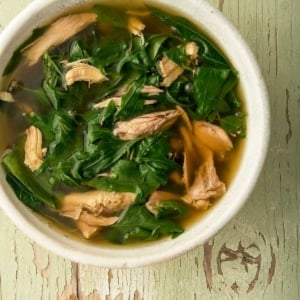
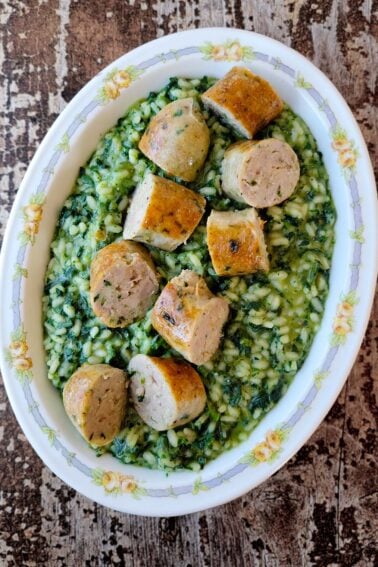
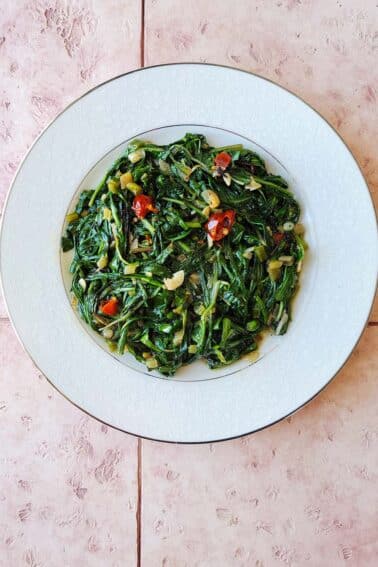

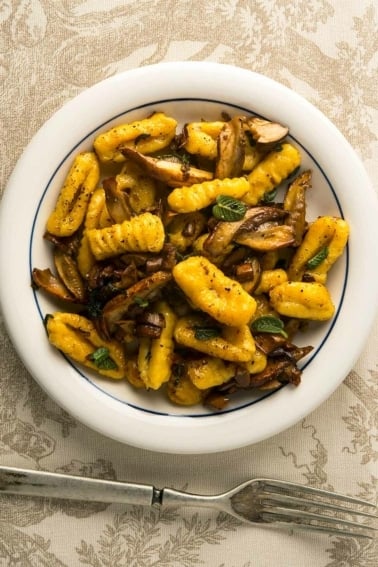
I was just thinking–and I know I said this to someone online–that Dad never really tried to grow grass in our yard, he just mowed the greenery that was already there. Mostly because his mother had taught him all about ‘edible weeds’ and he often harvested them from our lawn. When I weeded the garden or flower beds I had a wheelbarrow for the weeds we couldn’t use and a cloth bag for those we could. I also carried a knife to cut off the roots of weeds we could use so I didn’t track all that muck into the house. Trust me, before the spinach and lettuce came on or after it started bolting, those ‘weeds’ gave3 us some nice and tasty salads. Mom’s thrown many mixed ‘spring greens’ in a pot with a ham bone or the remains of a roast for a nice supper. The gardeners at my apartment building look at me strangely because I go out once a week and pull up weeds from the flower beds that I recognize to cook them–or just blanch and freeze for the winter.
I’m here in Fort Worth,Tx, ready to share the LQ I’ve allowed to grow all summer where if pleases. I’ve noticed the leaves shrink as the seed heads are maturing, so I’m eager for folks to volunteer to get some; or suggestions as easiest ways to preserve it for others. I’m allergic to it so shouldn’t eat it ( causes colon distress ).
Should I cut the tops of the stems/seed heads for different batching – then strip leaves for blanching and separate preparations? The plants are over 4’ and woody stemmed now.
I don’t cook much, but I do have a case of quart jars waiting for a project. Ez and fast , send ideas to me plz!
Lisa_stokdyk@yahoo.com
No bacon grease for us. Olive oil and garlic, then simmer until tender.
Mmm, I just finished my salad whit Fresh LQ + 2boiled eggs + minty yogurt dressing. I recently discovered it as edible plant and promote it to everyone. I like it more than lettuce.
I have a question do lambs quarter & epazota grow together in the wild? Out wild foraging & spoted these similar yet different greens growing on roadside by a squash field. Goggled them but not 100% sure.
Betty: Yes, I’ve seen them within 10 feet of one another.
Love your site! I often browse my land, eating a little of this, a little of that, raw and full of nutrients. We are so dependent on the grocery store for our food but we are surrounded by foodstuffs that we can harvest. : )
That is right. I check every wild/weed plant that grows on my allotment if it’s edible. Surprisingly many weeds are actually very nice like LQ.
Like Esther, I have good memories of trailing along behind my grandmother along roads on her farm as she picked lambsquarter and hopelessly tries to get me to help. Now I wish I could better identity it. Thanks so much for the map, that should help.
I dry lambsquarter leaves and store it in a jar. It rehydrates easily during cooking. I like to toss a handful of dry leaves in a soup for some green. Its very handy and stores for a long time.
I always love to see lambsquarters volunteer in my garden each year. I use it in my smoothies during the summer while spinach isn’t in season.
I grew up going with my Mom & GrandMother picking “greens”! Still go in the spring & pick the good ‘ole standards: Lambsquarters, Dock, both curly & straight leaf, Turkey Mustard, Peppergrass, Carpenter Square, Nettles…..my mouth is watering! GrandMother ate hers with Mustard & Vinegar, Mom with vinegar & mine, mine as is after cooking. I don’t like that extra stuff on mine. And the MORE nettles i put in & extra Carpenter Square, the better i like it. Of course u run into some that grew a bit faster than others so you devein those leaves & in they go. After partial cooking, they freeze really nice & when you thaw and finish cooking….tastes just like you have just picked & cooked! Very AWESOME
Thanks
Esther
I can’t wait to try all those greens you mentioned. Never heard of them. Thx
I always make pesto out of any lambsquarter I have to weed out of my garden spots. I wait until it’s in the way (tall & casting shadows). Just chop it up (I use a food processor) mixed w/a high quality olive oil, pack tightly into little jars, top w/more oil & use or freeze. No other ingredients needed… It’s great w/potatoes or in soups!
I much prefer lambsquarters to spinach, and always let a few plants flower and seed to make sure they continue. I haven’t tried the green seed heads, though – thanks for that information!
Hello Hank,
I was raised in N. Texas where you can find lambsquarters everywhere that the farmers haven’t managed to kill them. It took about a bushel of greens to feed 6 kids, so mom would fry some ham and add it to the pot of boiled greens. She would drain most of the juice, and add salt, lots of black pepper and cider vinegar. Wish I could find it here in NW New Mexico.
I always enjoy your posts, Hank, even if I don’t make the recipes.
Hank,
Im overly cautious when trying wild plants to eat. Are there any toxic plants that might be mistaken for lambsquarter, in North Carolina?
James
James: It depends. I don’t think so, but I’ve been picking wild edible plants for many, many years.
Nightshades are the closest looking.
Thank your articles on various less recognized plants. I’ve been defending the lowly lambsquarter in our garden for years, letting it appear as it chooses. It is always hardy and reliable, and a great addition to soups and sautees.
I had no idea that weed I keep pulling out of my garden was edible!
I am a farmer. I also own the local fishing store. We sell fishing gear as well as licenses for fishing and hunting. We live in a small seaside town along a major highway. I so enjoy your posts. Thank you for sharing many ways to savor our great land in the most natural, healthful and delicious way. Tania from TheSheepishPig.com and Kingston Mercantile & Marine.
Great to hear about some of the other species. I’d love to try C. nuttalliae, they look super big and beefy. I have a blend of C. album and it’s cousin magenta spreen, typical, but it makes up about 50% of the wild greens we eat. Such a good food plant.
What about the lambs quarter we have in the East?
It has the whiteish , soft leaf , like a lambs ear?
Jay: Yep, that’s C. album, very edible!
Here in the east when people say “lambs ear” they are often referring to rose campion or perhaps stachys Byzantina or even mullein. There are medicinal uses for those but they are not the same as lambs quarters and I personally wouldn’t want to put anything that fuzzy into my mouth.